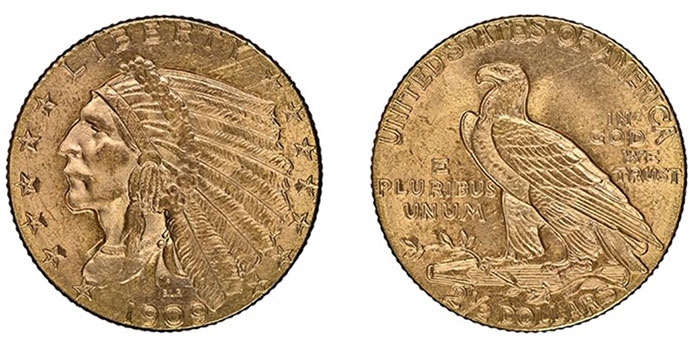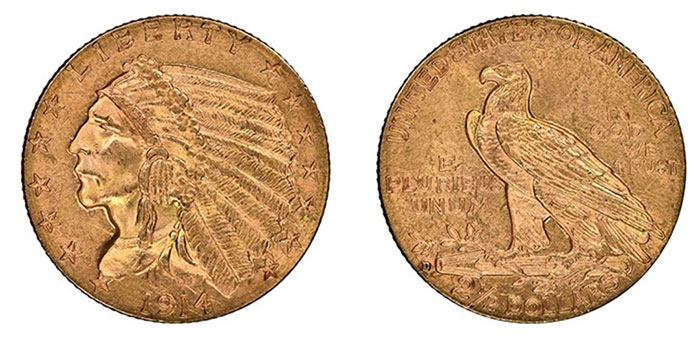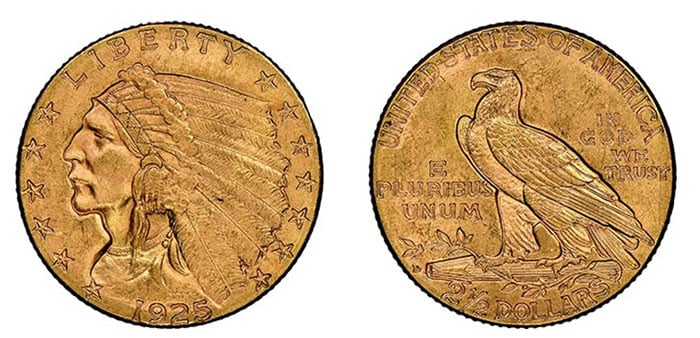Collecting a complete set of any series of United States gold coins is a formidable task. Very few accept the challenge, as most series contain several “stoppers” that make completion almost impossible. Consider Saint-Gaudens Double Eagles as an example. The series starts with the 1907 High Relief and ends with the most expensive coin in the world, the 1933 Double Eagle. Most other series of United States gold coins are similarly difficult to complete.
The Indian Quarter Eagle set (1908-1929) is a less challenging task to tackle, and only has one date that is a “stopper” to acquire for completeness. The 1911-D Quarter Eagle is the “key” date, but it can still be found relatively easily. The cost for this issue starts around $2,500 USD for low-grade examples. Most of the remaining coins are only difficult to locate in grades of MS 63 and better. More about that in the date-by-date analysis below.
As anyone who has filled a blue Whitman folder can tell you, the satisfaction of completing a set of anything is quite fulfilling. The fun of the chase and the knowledge you acquire when searching is what numismatics is all about. Collecting United States gold coins by date and mintmark is beyond the reach of most collectors, but completing a set of Indian Quarter Eagles can be done for those who want to make the commitment and investment.
The biggest obstacle for the series is deciding which grade to collect. For a matched set, you should first decide how much you can spend to acquire the 1911-D. If a low-grade example better fits your budget, then the others can be found in the same grade or slightly better. If quality is important (as it should be), then you will need to study current auction records and decide which grade is best for you. You can then start the task of looking for the other dates. Some collectors like to find the more common dates first, so they can have a head start on completeness. If you are thinking about Gem MS 65 or better coins, then you are in for a long process of acquisition. The 1911-D is not the only rare issue in Gem condition.
In the old days, before rare coin certification, this set was usually offered in an attractive Capital Plastics holder. Coins in these sets would usually range in grade and sometimes contained coins of questionable authenticity. Unfortunately, these coins are among the most counterfeited of all US gold coins. Collectors today have a much easier task, as most focus on grades that fit their budgets and they know that when buying certified coins, there are fewer concerns about authenticity.
Over the past few years, an incredible amount of vintage United States gold has entered the market from sources overseas. The vast majority of the coins are Half Eagles, Eagles, and Double Eagles. Rarely do large groups of Gold Dollars and Quarter Eagles show up, virtually none from overseas gold hoards. This gives buyers some assurance of available supply going forward.
Quarter Eagles were very utilitarian and circulated widely as opposed to some of the higher denominations. Well-worn examples are not uncommon. High-grade examples often exhibit bag marks and nearly flawless Gems are virtually unknown, even for the most common dates. An MS 66 would be the best example usually available for those interested in one for a Type set.
If you decide to accept the challenge, hopefully the information below will be of help.
A Year-by-Year Look at the Indian Quarter Eagle
1908, mintage: 565,057

The new design for the Quarter Eagle for the first time featured an incuse design. The portrait and eagle are lowered into the surface. That is why grading the series can be difficult, as the highest points for the issue are the obverse and reverse fields. The new design was created by Bela Lyon Pratt, and features a Native American Indian chief on the obverse and an eagle facing left on the reverse.
The date was saved extensively as a first-year-of-issue and can usually be found in most grades with modest effort. Most examples lack definition on the upper portion of the eagle’s wing. Many are also found with rather severe die clashes that can sometimes confuse the novice as to the authenticity of the coin. Although many were saved, MS 66 coins are quite rare, and only about 70 have been graded by NGC to date. Just three coins have been certified as MS 67, and one achieved MS 67+. The last MS 67 that sold at auction brought $37,375 in 2006.
1909, mintage: 441,889

In lower grades, the 1909 is readily obtainable. Most are well struck in comparison to the 1908 issue, and usually feature light, green-gold coloration. The 1909 issue is scarce at the Gem MS 65 level (197 graded), with four or five usually crossing the auction block each year. Only about two dozen have been graded as Superb MS 66. None have been certified as MS 67 or higher. In 2014, an MS 66 sold at auction for $14,100.
1910, mintage: 492,682

The luster and strike for the 1910 is very similar to that of the 1909 issue. Some, however, are seen with weakness of strike near the rims on both the obverse and reverse. The coins look very “mushy” and can be confused with poorly made counterfeits. Lower-grade examples are very easy to purchase, but in Gem condition the date becomes quite rare, with less than 200 coins certified at that level. Superb examples are almost non-existent, with only 19 certified as MS 66. An MS 66 coin broke records in January of this year, selling for $24,000.
1911, mintage: 704,191
Quarter Eagles struck in 1911 have a much more granular appearance. The luster is more subdued, and the strike can sometimes be weak on the eagle’s wingtip. Mid-range Mint State coins are slightly scarcer than the later issues. In the higher grades of Mint State, the issue becomes quite rare. NGC reports a population of only 172 MS 65 coins and just eight at the MS 66 level. Collectors should remember that the Indian Head Quarter Eagle series is highly collected and coins with low survival rates in Gem condition are always in high demand. An NGC MS 66 coin sold for $20,400 in 2019.
1911-D, mintage: 55,680

This date is the undisputed key to the series. Because of its low mintage and survival rate, this date brings a healthy price in circulated condition. The 1911-D Indian Quarter Eagle has by far the smallest mintage, and it seems that surprisingly few were saved. The issue is usually well struck and is peculiar in that nearly every genuine example is seen with a pronounced wire rim on the obverse. This feature is a diagnostic of the date and is even seen on examples that have a very weak D mintmark. It is recommended to avoid the weak D examples of this date. The resale value of these is usually quite soft.
The 1911-D is not the rarest Indian Quarter Eagle in MS 65 condition, but it is certainly the most expensive. The date is extremely rare in superb condition. Just three examples have been graded by NGC at that level, one of which sold for $132,000 in 2021. Many collectors who tackle this series will be looking for an attractive MS 62 or MS 63 example. Hundreds have been graded at those levels but finding one that is attractive and fairly price will be difficult. Be sure to examine several coins before making your purchase. The success of your investment in this set will most likely hinge on this one coin.
1912, mintage: 616,197

As can be seen from the rather high mintage figure for the date, the issue is rather common in circulated condition and the lower Mint State grades. The date is sometimes softly struck with a shallow appearance. The 1912 Quarter Eagle is somewhat scarce in Choice condition and becomes very rare at the Gem level. Just a few examples are offered at auction each year in Gem condition. The most recent NGC example sold for $6,900 in 2019. Just four 1912 Indian Quarter Eagles have been certified as MS 66 and none of these have crossed the auction block. Interestingly, the date is sometimes accumulated by marketers and sold as a tangible link to the 1912 sinking of the Titanic.
1913, mintage: 722,165

The production of Quarter Eagles continued in 1913 at a rather healthy pace and finding an example of the issue is a simple matter in most grades. The surface and luster of the issue are somewhat dull, but most are seen well struck. The date becomes rare at the Gem level, with only 110 coins certified. The date is extremely rare in MS 66 condition (five graded), and I have only seen one or two that would qualify as that grade. It is interesting that for a date that can be found in prodigious quantities, the issue is unknown in MS 67 condition.
1914, mintage: 240,117

As can be seen from the rather sharp drop in mintage, the 1914 is one of the scarcer coins for the series. It is considered the second-best date and is difficult to obtain at any level of Mint State. The price of a 1914 Indian Quarter Eagle jumps rather sharply when going from one grade to the next and is a favorite of the re-submitters. The population numbers should be viewed with some skepticism, as many of the tags were not returned for correction of the population reports.
As would be expected, the 1914 is very rare in Gem condition (51 graded), with just one or two trading hands at auction each year. Only three coins have been certified as MS 66, none of which have sold at auction.
1914-D, mintage: 448,000

Like the 1914 Philadelphia issue, the 1914-D was not saved and circulated widely. Low-grade examples can be found rather easily, but in Choice and Gem condition the date is very rare. Most, but not all, examples of the date are found with ill-defined details on both the obverse and reverse. A small number were struck with dies that were well prepared and should bring a premium. The 1914-D does not have the same status as the popular 1914 issue, but is actually rarer in Gem condition (45 graded) than the 1914. An NGC MS 65 coin sold at auction in 2012 for $28,750.
1915, mintage: 606,100

Despite the continuance of World War I, the production for the Indian Quarter Eagle actually increased somewhat from the year before. The date is quite common in all grades below the Gem level and can be found with little difficulty. Amazingly, only 12 coins have been graded MS 66, one of which sold for $21,000 in 2014.
1925-D, mintage: 578,000

After a decade-long gap in production, the Indian Head Quarter Eagle appeared once again. The Denver Mint was brought into action and produced like that of earlier years. For some reason, this and later dates were saved in large numbers. The 1925-D is the most common of the series and can be found in all grades up to MS 65 with little difficulty. The luster for the issue is among the best for the series, but the date can sometimes be found weakly struck. The 1925-D is one of the few dates that has an example that has been certified as MS 67.
1926, mintage: 446,000

The 1926 Indian Quarter Eagle is among the most common issues for the series. The date can be found in all grades, including MS 65. All of the late-date (1925-D to 1929) issues are usually purchased as examples for the type. Superb examples are very rare and none have been graded MS 67.
1927, mintage: 388,000

The 1927 Indian Quarter Eagle is similar in rarity to the above two issues and can be found in all grades below MS 66. Most are well struck with excellent luster. The date is ideal for Type coin collectors. Superb coins are surprisingly rare with just 13 coins certified by NGC as MS 66.
1928, mintage: 416,000

Most examples seen for the date are well struck with excellent luster. The date is among the better produced for the series and is ideal for type coin collectors as well. As is the common theme for the late-date coins from the series, a small number have been graded MS 66, but none have achieved the MS 67 designation.
1929, mintage: 532,000

The start of the Great Depression brought an end to this short-lived series. The 1929 is the last year of production and can be found in ample quantities. Most are nicely struck with great luster. For some reason, this date is found with more than average bag marks, and at the Gem level, it is actually somewhat rarer than the other dates from 1925 to 1928. Only about 300 have been certified by NGC as MS 65 and the date brings a healthy premium in Gem condition. Just six coins have been certified as MS 66 and, as such, it is one of the most elusive at that grade for the series in Gem condition.
